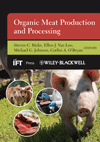77th Reciprocal Meat Conference focuses on product development strategies
Functional broths offer processors flexibility in crafting formulations.

Photo credit: Fred Wilkinson
Presenters Michael Kropp (from left), Danika Miller and Brandy Coley take questions from the audience during the June 17 session Basic, Applied and Social Science Driving Development as part of RMC 2024 in Oklahoma City.
OKLAHOMA CITY — This year’s Reciprocal Meat Conference marks not just the 77th time the meeting has taken place, but also the American Meat Science Association’s 60th year.
RMC 2024 kicked off June 16, culminating by leaning in to the event venue’s cattle country roots with an opening reception at the National Cowboy & Western Heritage Museum.
RMC 2024’s packed agenda for June 16-19 — including keynote speaker Illinois farmer and podcaster Rob Sharkey (better known as The Shark Farmer) — featured a supplier showcase and broad range of workshops examining production, regulatory and consumer trends steering innovation for meat and poultry products.
Among the June 17 lineup of educational sessions was a presentation titled Basic, Applied and Social Science Driving Development, which covered challenges and strategies for developing clean-label protein products.
Presenter Michael Kropp of Kemin Food Technologies said 64% of US consumers say they try to purchase foods made with clean ingredients, and 25% say they seek health benefits from food.
Kropp said the US market for clean-label foods is estimated to reach $42 billion by the end of 2030, with a compound annual growth rate of 18%.
Presenter Danika Miller said formulating a clean-label meat product requires processors to satisfy consumers' expectations for fresh, flavorful meat products that are simply made for a reasonable price.
Miller, who does research and development at Tyson Foods, said that means processors must find ways to reduce ingredients with chemical-sounding names, including ingredients such as:
- phosphates, which can be replaced with functional stocks and/or fibers
- caramel color, by subbing in non-sugar natural browning agents and flavors
- lactates and diacetates, by substituting buffered vinegars and cultured sugars
- sodium nitrite, by incorporating celery powder
- corn syrup, by using dextrose, fibers, functional stocks and broth.
Shortening a label deck can be as straightforward as changing ingredients from including water and dehydrated turkey broth to simply using turkey broth, she said.
Presenter Brandy Coley, national account manager for Essentia Protein Solutions, said among the advantages of incorporating stocks and broths into a product formulation is that they are 100% all-natural meat protein that enhances products' meaty notes. Functional broths can be introduced via injecting, tumbling or mixing, she said. Other attributes broths boast are increasing water-binding capacity, purge reduction, texture enhancement, improved processing yields, emulsion stability and sodium reduction.
Reformulating brings with it other considerations, including its effect on costs for inputs and product quality attributes such as flavor, color, texture and shelf life, as well as effects on processing (blending, forming, injecting), Miller said.
Kropp said clean-label ingredient options that will foster product moisture retention include:
- baking soda
- carbonates
- plant fibers (citrus and oats)
- proteins such as whey, egg whites, plant proteins flour, textured vegetable proteins, collagen and solubilized myofibrular.
Looking for a reprint of this article?
From high-res PDFs to custom plaques, order your copy today!
.png?height=96&t=1647275041&width=96)






